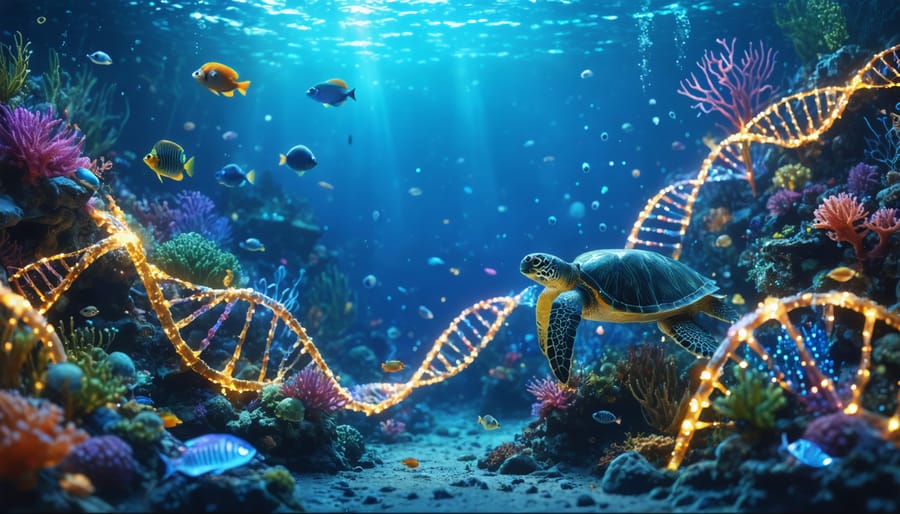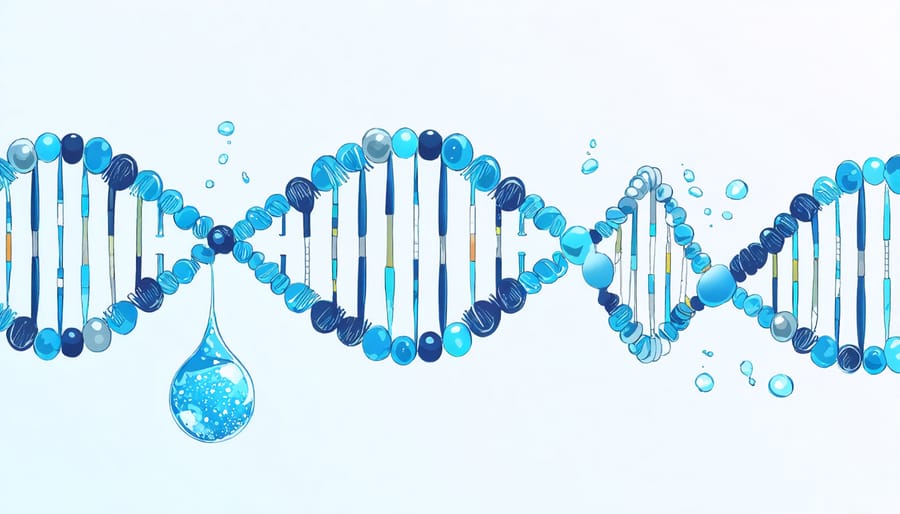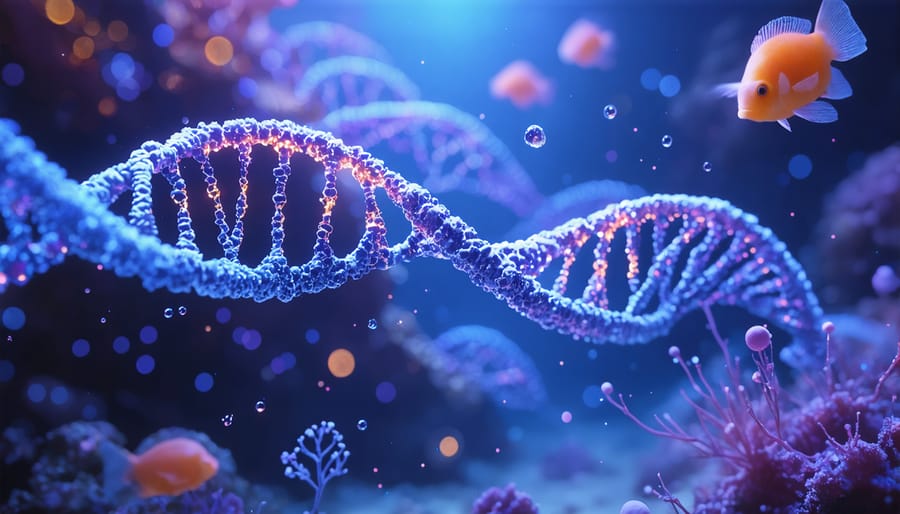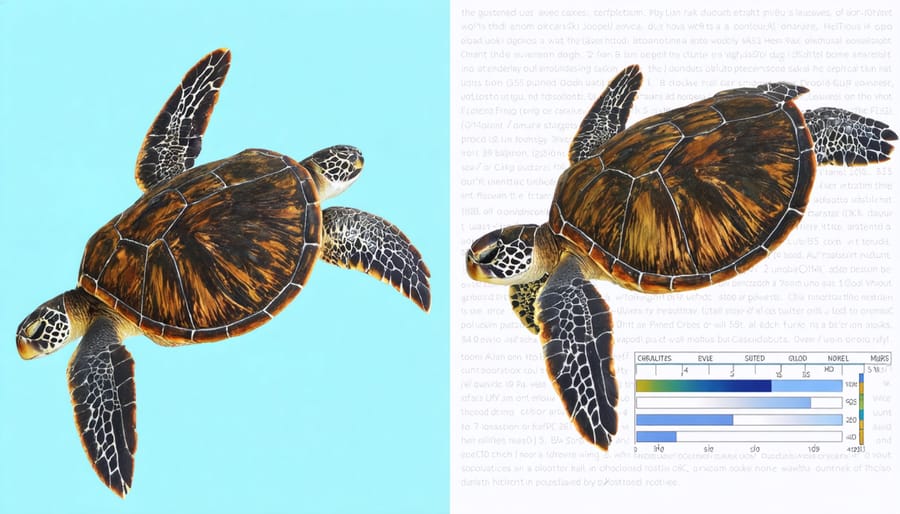
At the intersection of big data and biology, genomics machine learning is revolutionizing our understanding of marine ecosystems. By analyzing vast datasets of genetic information, researchers can now decode complex marine species interactions with unprecedented accuracy. This emerging field combines advanced artificial intelligence algorithms with genomic sequencing to identify patterns, predict environmental responses, and unlock insights that were previously impossible to discover.
From tracking endangered species populations through environmental DNA to predicting coral reef resilience in the face of climate change, machine learning tools are transforming how we study and protect marine biodiversity. These innovative approaches process millions of genetic markers simultaneously, enabling scientists to map intricate relationships between species, monitor ecosystem health in real-time, and develop more effective conservation strategies.
As computational power increases and algorithms become more sophisticated, the marriage of genomics and machine learning promises to accelerate our understanding of marine life while providing crucial tools for biodiversity preservation. This technology represents not just a scientific advancement, but a vital hope for protecting our oceans’ future.
The Power of Genomic Data in Marine Conservation
DNA Barcoding and Environmental DNA
DNA barcoding and environmental DNA (eDNA) analysis have revolutionized how we monitor marine biodiversity, becoming essential tools in modern ocean conservation efforts. These techniques allow scientists to identify species and track population changes by collecting and analyzing genetic material from water samples, making it possible to detect marine life without direct observation.
Machine learning algorithms process vast amounts of genetic data from these samples, identifying species-specific DNA sequences and tracking their distribution patterns. This technology has proven particularly valuable in detecting rare or invasive species, monitoring ecosystem health, and understanding migration patterns of marine organisms.
For example, researchers can now analyze water samples from different ocean depths to create comprehensive biodiversity maps, revealing the presence of everything from microscopic plankton to large marine mammals. The combination of DNA sampling and AI-powered analysis has dramatically reduced the time and cost of marine surveys while increasing their accuracy and scope.
Citizen scientists and volunteer groups are increasingly participating in eDNA collection programs, contributing to our understanding of marine ecosystems while learning about cutting-edge conservation technology.

Building Genetic Libraries of Marine Life
Building comprehensive genetic libraries of marine species has become a cornerstone of modern conservation efforts. Scientists worldwide are collecting and cataloging DNA samples from diverse marine organisms, from microscopic plankton to large marine mammals. These genetic databases serve as vital reference points for biodiversity assessment and species identification.
The Ocean Genome Atlas, a collaborative initiative involving marine research institutions globally, has already documented over 30,000 species’ genetic information. This growing database enables researchers to track population changes, identify new species, and monitor ecosystem health through environmental DNA (eDNA) sampling.
Marine biologist Dr. Sarah Chen explains, “Every DNA sample we collect is like adding a new book to nature’s library. These databases help us understand not just what species exist, but how they’re related and how they’re adapting to environmental changes.”
Citizen scientists are also contributing to this effort through initiatives like the Global Marine DNA Project, where recreational divers and coastal communities can help collect samples. This collaborative approach has accelerated the mapping of marine genetic diversity, particularly in understudied regions.
Machine Learning Applications in Marine Genomics

Species Identification and Classification
Modern genomics has revolutionized how we identify and classify marine species, with AI-powered species analysis leading the way. Machine learning algorithms can now process vast amounts of genetic data from environmental DNA (eDNA) samples, enabling researchers to identify multiple species from a single water sample.
These sophisticated algorithms work by comparing genetic sequences against extensive databases of known marine species. When faced with new or unusual genetic patterns, the systems can flag potential discoveries of previously unknown species, making them invaluable tools for biodiversity research.
The process begins with DNA barcoding, where specific genetic markers are used to identify species. Machine learning models then analyze these markers, looking for patterns and variations that distinguish different species. What makes this technology particularly powerful is its ability to learn and improve over time – the more data it processes, the more accurate its classifications become.
For example, researchers studying coral reef ecosystems can now identify hundreds of fish species from water samples in a matter of hours, a task that would have taken weeks or months using traditional methods. These tools are especially valuable when dealing with cryptic species – organisms that look identical but are genetically distinct.
The technology has also proven crucial in tracking invasive species and monitoring endangered populations. By analyzing genetic data from different locations over time, researchers can track species movement patterns and population changes, providing vital information for conservation efforts. This rapid and accurate identification system has become an essential tool in marine biodiversity research and conservation planning.
Population Health Assessment
Machine learning applications in genomics have revolutionized our ability to assess and monitor population health across marine ecosystems. By analyzing vast datasets of genetic information from multiple species, researchers can now track population trends, genetic diversity, and evolutionary adaptations with unprecedented accuracy.
These advanced algorithms can process DNA sequences from thousands of marine organisms simultaneously, identifying patterns that might indicate population decline, genetic bottlenecks, or increasing diversity. For instance, scientists studying coral reef communities use ML tools to analyze genetic markers across different coral species, helping them understand how populations respond to environmental stressors like ocean acidification and warming waters.
Dr. Sarah Chen, a marine geneticist at Pacific Ocean Institute, shares her experience: “Machine learning has transformed how we monitor whale populations. We can now process environmental DNA samples from seawater and instantly identify which species are present, their approximate numbers, and even their genetic health.”
The technology also helps identify vulnerable populations before visible signs of decline appear. By analyzing genetic variations within species, ML algorithms can predict which populations might be at risk due to reduced genetic diversity or environmental pressures. This early warning system allows conservation efforts to be implemented proactively rather than reactively.
Recent success stories include tracking the genetic recovery of humpback whale populations and identifying previously unknown genetic diversity in deep-sea communities. These insights help marine park managers and conservation organizations make data-driven decisions about protection measures and habitat restoration efforts.
Machine learning tools have also made genetic monitoring more accessible to smaller research teams and conservation groups, democratizing access to powerful population assessment tools that were once available only to large research institutions.
Real-World Success Stories
Tracking Endangered Species Recovery
Machine learning algorithms are revolutionizing how we track and protect endangered marine species through genomic analysis. By analyzing environmental DNA (eDNA) samples collected from seawater, researchers can now monitor entire populations without direct animal contact. This non-invasive approach has proven particularly valuable for tracking critically endangered species like the vaquita porpoise and North Atlantic right whale.
In a groundbreaking project off the California coast, scientists developed a machine learning model that processes genomic data from water samples to estimate population sizes, track migration patterns, and assess genetic diversity of threatened marine mammals. The algorithm can identify individual animals from their genetic signatures and predict population trends with over 90% accuracy.
Marine biologist Dr. Sarah Chen, who leads the project, explains: “Traditional tracking methods like tagging are stressful for animals and provide limited data. With genomics ML, we can monitor entire populations by simply collecting water samples, giving us unprecedented insights into species recovery.”
The technology has already helped identify previously unknown breeding grounds for endangered sea turtles and revealed promising signs of genetic diversity in recovering whale populations. Citizen scientists can contribute to these efforts by collecting water samples during organized beach clean-ups, making conservation more accessible to the public while generating valuable data for researchers.

Invasive Species Detection
Machine learning has revolutionized our ability to detect and monitor invasive species through genetic analysis, offering unprecedented accuracy and speed in identifying potential threats to marine ecosystems. By analyzing DNA sequences and genetic markers, ML algorithms can quickly distinguish between native and non-native species, even when visual identification is challenging or impossible.
Environmental DNA (eDNA) sampling, combined with machine learning models, allows scientists to detect invasive species before they become visible to the human eye. These models process vast amounts of genetic data from water samples, identifying trace amounts of DNA shed by organisms and flagging potential invaders. This early warning system has proven particularly valuable in ports and high-risk areas where invasive species often first appear.
Success stories include the early detection of invasive European green crabs along the Pacific Coast and identifying lion fish populations in the Caribbean. ML algorithms have achieved detection rates of over 95% accuracy in some cases, significantly improving our response time to potential threats.
Citizen scientists are also contributing to these efforts by collecting water samples and helping to build comprehensive genetic databases. The combination of community involvement and advanced ML technologies has created a powerful network for monitoring marine ecosystems and protecting native species from invasive threats.
These tools are particularly valuable in remote or hard-to-monitor areas, where traditional surveillance methods might be impractical or cost-prohibitive. As the technology continues to evolve, we’re seeing increased integration with mobile applications and portable DNA sequencing devices, making invasive species detection more accessible to conservation teams worldwide.
Future Prospects and Getting Involved
Emerging Technologies
Recent breakthroughs in genomics machine learning are transforming how we understand and protect marine ecosystems. Among the most promising conservation technologies is the development of automated DNA sequencing platforms that can process environmental DNA (eDNA) samples in real-time aboard research vessels.
These cutting-edge systems combine portable sequencing devices with advanced neural networks to identify multiple marine species simultaneously from water samples. Scientists are now using deep learning algorithms that can detect subtle genetic variations indicating population health, migration patterns, and even signs of adaptation to climate change.
A groundbreaking development is the integration of blockchain technology with genomic databases, ensuring transparent and secure sharing of genetic data across international research teams. This has led to the creation of a global marine genetic catalogue that helps track endangered species and monitor biodiversity changes.
Quantum computing applications are also emerging in genomics analysis, promising to dramatically reduce the time needed to process complex genetic data. These systems can analyze millions of genetic sequences in hours rather than weeks, enabling rapid response to environmental threats.
Edge computing devices are being deployed on autonomous underwater vehicles, allowing for immediate genomic analysis in remote ocean locations. This technology helps researchers identify and track invasive species, monitor coral reef health, and assess the impact of conservation efforts in real-time.
Citizen Science Opportunities
Excited to contribute to marine genomics research? Several citizen science initiatives now allow enthusiasts and students to participate in groundbreaking research from home. Zooniverse’s Plankton Planet project enables volunteers to classify plankton images, helping train machine learning algorithms to better identify marine species. Meanwhile, the Ocean Genome Atlas project invites citizen scientists to help annotate genetic sequences from marine organisms.
For hands-on experience, programs like eDNA Explorer allow volunteers to collect water samples from local water bodies, which researchers analyze for environmental DNA. The data collected helps create comprehensive genetic maps of marine ecosystems. The Global Marine Biodiversity Project also welcomes citizen contributions through their mobile app, where users can photograph and document marine species, contributing to a growing database that trains AI models.
Students and educators can participate through classroom initiatives like the Marine Genomics Network, which provides curriculum materials and real research data for analysis. The platform connects classrooms with marine scientists, offering students the opportunity to work with actual genomic datasets.
These projects not only advance scientific understanding but also help improve machine learning models through diverse data inputs. By participating, citizen scientists contribute to the development of more accurate species identification algorithms and better understanding of marine ecosystem health. Most programs require only a computer or smartphone and enthusiasm for marine conservation.
The convergence of genomics and machine learning represents a powerful frontier in marine conservation, offering unprecedented insights into ocean biodiversity and species preservation. Through these advanced technologies, we can now track genetic changes in marine populations, predict species’ responses to environmental stressors, and develop more effective conservation strategies with greater precision than ever before.
As our oceans face mounting challenges from climate change, pollution, and habitat destruction, the role of genomics ML becomes increasingly crucial. These tools not only help us understand the current state of marine ecosystems but also enable us to predict and potentially prevent future biodiversity losses. The success stories we’ve seen – from protecting endangered coral species to managing sustainable fisheries – demonstrate the tangible impact of this technology on ocean conservation efforts.
However, the future of marine conservation through genomics ML depends on collective action and support. Whether you’re a scientist, student, or concerned citizen, there are numerous ways to contribute to these efforts. Consider participating in citizen science projects that collect genetic data, supporting research institutions that develop these technologies, or advocating for policies that protect marine ecosystems while enabling scientific research.
As we look ahead, the continued development and application of genomics ML in marine conservation will be vital for preserving our ocean’s biodiversity for future generations. The time to act is now – every contribution, whether through direct participation, education, or advocacy, brings us closer to ensuring the health and resilience of our marine ecosystems.
jessica
Ava Singh is an environmental writer and marine sustainability advocate with a deep commitment to protecting the world's oceans and coastal communities. With a background in environmental policy and a passion for storytelling, Ava brings complex topics to life through clear, engaging content that educates and empowers readers. At the Marine Biodiversity & Sustainability Learning Center, Ava focuses on sharing impactful stories about community engagement, policy innovations, and conservation strategies. Her writing bridges the gap between science and the public, encouraging people to take part in preserving marine biodiversity. When she’s not writing, Ava collaborates with local initiatives to promote eco-conscious living and sustainable development, ensuring her work makes a difference both on the page and in the real world.
